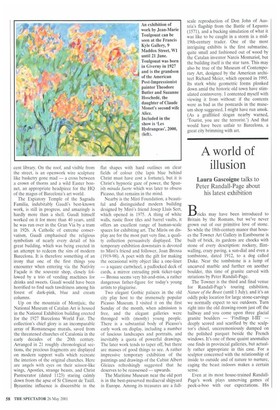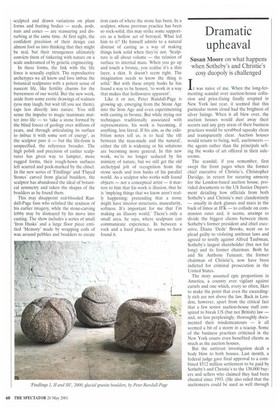A world of illusion
Laura Gascoigne talks to Peter Randall-Page about his latest exhibition
Bricks may have been introduced to Britain by the Romans, but we've never grown out of our primitive love of stone. So while the 18th-century manor that houses the Towner Art Gallery in Eastbourne is built of brick, its gardens are chocka with stone of every description: rockery, flintwalling, crazy paving, a sun-dial and even a tombstone, dated 1912, to a dog called Duke. Near the tombstone is a lump of uncarved marble and further on another boulder, this time of granite carved with striations by Peter Randall-Page.
The Towner is the third and final venue for Randall-Page's touring exhibition, Nature of the Beast (until 1 July), and it's an oddly poky location for large stone-carvings we normally expect to see outdoors. Turn right into the old drawing-room just off the hallway and you come upon three glacial granite boulders — 'Findlings I-III' — deeply scored and scarified by the sculptor's chisel, unceremoniously dumped on the polished parquet beside the French windows. It's one of those quaint anomalies one finds in provincial galleries, but actually rather appropriate in this case. For a sculptor concerned with the relationship of inside to outside and of nature to nurture, caging the beast indoors makes a certain sense.
Even at its most house-trained RandallPage's work plays unnerving games of peek-a-boo with our expectations. His sculpted and drawn variations on plant forms and fruiting bodies — seeds, pods, nuts and cones — are reassuring and disturbing at the same time. At first sight, the confident precision of their design can almost fool us into thinking that they might be real, but their strangeness ultimately convicts them of tinkering with nature on a scale undreamed of by genetic engineering.
In these forms, the link with the life force is sexually explicit. The reproductive archetypes we all know and love imbue the botanical sculptures with a potent sense of nascent life, like fertility charms for the barrenness of our world. But the new work, aside from some erotic drawings of walnuts (you may laugh, but wait till you see them), taps less directly into nature. You still sense the impulse to magic inanimate matter into life — to 'take a stone formed by the blind forces of geology over millions of years, and through articulating its surface to imbue it with some sort of energy', as the sculptor puts it — but the life-form is unspecified, the reference broader. The high polish and precision of earlier sculptures has given way to lumpier, more rugged forms, their rough-hewn surfaces left scarred and pock-marked by the chisel. In the new series of `Findlings' and 'Flayed Stones' carved from glacial boulders, the sculptor has abandoned the ideal of botanical symmetry and taken the shapes of the boulders as he found them.
This may disappoint red-blooded Randall-Page fans who relished the sexiness of his earlier imagery, while the stone-carving lobby may be dismayed by his move into casting. The show includes a series of small 'Iron Husks' and a large floor piece entitled 'Memory' made by wrapping coils of wax around pebbles and boulders to create iron casts of where the stone has been. In a sculptor, whose previous practice has been so rock-solid, this may strike some supporters as a hollow act of betrayal. What led him to it? He himself admits to a natural distrust of casting as a way of making things look solid when they're not. 'Sculpture is all about volume — the relation of surface to internal mass. When you go up and touch a bronze, you realise it's a thin layer, a skin. It doesn't seem right. The imagination needs to know the thing is solid.' But with these empty husks he has found a way to be honest, 'to work in a way that makes that hollowness apparent'.
Like it or not, Peter Randall-Page is growing up, emerging from the Stone Age into the Iron Age and even experimenting with casting in bronze. But while trying out techniques traditionally associated with representation, his work is becoming, if anything, less literal. If his aim, as the exhibition notes tell us, is to heal 'the rift between the man-made and the natural', either the rift is widening or his solutions are becoming more general. In this new work, we're no longer seduced by his mimicry of nature, but we still get the old archetypal jolt of recognition from the stone seeds and iron husks of his parallel world. As a sculptor who works with found objects — not a conceptual artist — it matters to him that his work is illusion, that he is 'implying things that we know aren't really happening: pretending that a stone might have interior structures, muscularity, softness. It's important for me that I'm making an illusory world.' There's only a small area, he says, where sculpture can communicate experience. In between a rock and a hard place, he seems to have found it.



















































































 Previous page
Previous page